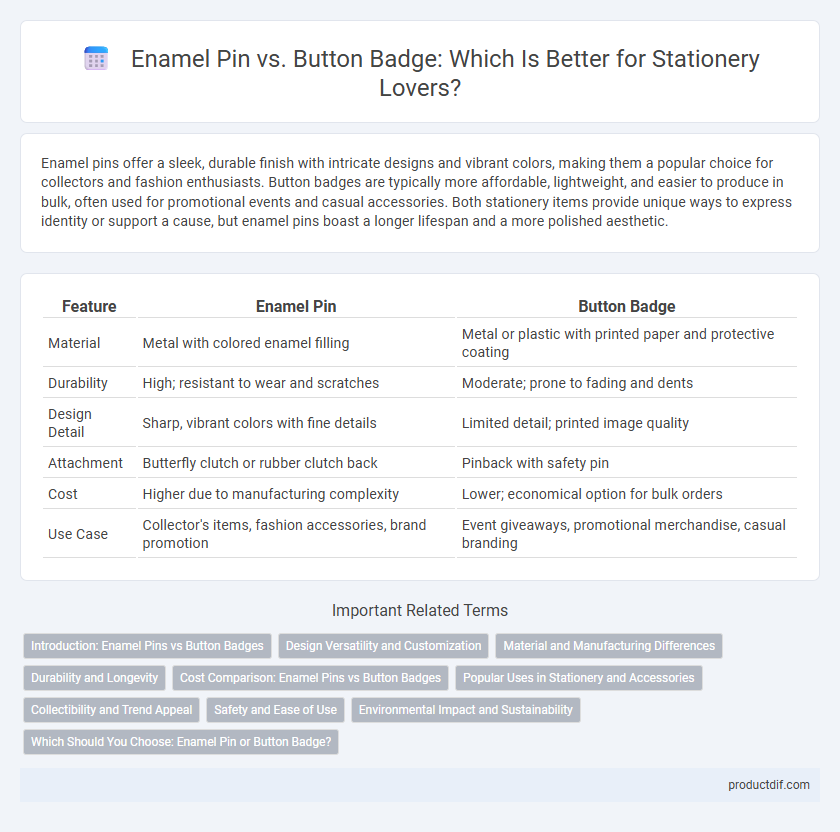Enamel pins offer a sleek, durable finish with intricate designs and vibrant colors, making them a popular choice for collectors and fashion enthusiasts. Button badges are typically more affordable, lightweight, and easier to produce in bulk, often used for promotional events and casual accessories. Both stationery items provide unique ways to express identity or support a cause, but enamel pins boast a longer lifespan and a more polished aesthetic.
Table of Comparison
| Feature | Enamel Pin | Button Badge |
|---|---|---|
| Material | Metal with colored enamel filling | Metal or plastic with printed paper and protective coating |
| Durability | High; resistant to wear and scratches | Moderate; prone to fading and dents |
| Design Detail | Sharp, vibrant colors with fine details | Limited detail; printed image quality |
| Attachment | Butterfly clutch or rubber clutch back | Pinback with safety pin |
| Cost | Higher due to manufacturing complexity | Lower; economical option for bulk orders |
| Use Case | Collector's items, fashion accessories, brand promotion | Event giveaways, promotional merchandise, casual branding |
Introduction: Enamel Pins vs Button Badges
Enamel pins feature vibrant, hard or soft enamel surfaces with metal backing, offering durability and a premium finish compared to button badges. Button badges are typically made with a metal or plastic base and a printed design covered by a protective plastic film, making them cost-effective and lightweight. Both serve as popular stationery accessories for personalization, branding, or collector's items, but enamel pins provide a higher-end aesthetic while button badges excel in affordability and ease of production.
Design Versatility and Customization
Enamel pins offer intricate detailing and a polished finish, making them ideal for designs requiring precision and vibrant colors, while button badges provide larger surface areas suited for bold graphics and text-heavy designs. Customization options for enamel pins include multiple layers, plating choices, and enamel types like soft or hard, whereas button badges allow for quick, cost-effective mass production with full-color printing on various sizes. Both stationery items cater to unique branding needs, but enamel pins excel in premium, durable looks, and button badges thrive in flexible, budget-friendly customization.
Material and Manufacturing Differences
Enamel pins are typically made from metal with enamel paint filled into recessed areas, offering a durable and high-quality finish, while button badges consist of a metal or plastic base covered with printed paper and a protective plastic film. The manufacturing of enamel pins involves a detailed process of stamping, plating, and hand or machine enameling, resulting in a hard, glossy surface that resists wear. Button badges are produced more quickly through mass-printing and pressing methods, making them a cost-effective option with a lighter and less durable feel.
Durability and Longevity
Enamel pins offer superior durability and longevity compared to button badges due to their hard metal construction and enamel coating, which resists scratches and fading. Button badges, often made from thin metal and plastic with a printed paper insert, are more susceptible to bending, cracking, and color wear over time. Collectors and retailers favor enamel pins for long-term use and preservation because their robust materials ensure they maintain quality and appearance even with frequent handling.
Cost Comparison: Enamel Pins vs Button Badges
Enamel pins typically cost more than button badges due to their intricate metalwork and durable enamel coating, often ranging from $3 to $7 each depending on size and complexity. Button badges are more budget-friendly, usually priced between $0.50 and $2 per unit, benefiting from cheaper materials like metal or plastic with printed designs. Businesses choosing between the two should consider enamel pins for premium branding and long-term durability, while button badges offer cost-effective options for large-volume giveaways or promotions.
Popular Uses in Stationery and Accessories
Enamel pins are popular in stationery and accessories for their durable metal finish and intricate designs, often used to personalize notebooks, backpacks, and pencil cases. Button badges are favored for promotional purposes and events due to their lightweight construction and customizable printed surface, making them ideal for giveaways and branding. Both items enhance stationery collections by adding unique, expressive elements that appeal to collectors and enthusiasts.
Collectibility and Trend Appeal
Enamel pins exhibit higher collectibility due to their durable metal construction, intricate designs, and vibrant colors that appeal to enthusiasts seeking long-lasting, unique pieces. Button badges offer trend appeal with their lightweight, cost-effective production and ability to showcase bold, customizable graphics, making them popular for short-term fashion statements and event promotions. Collectors often prioritize enamel pins for their premium quality and exclusivity, while button badges attract mass-market audiences driven by current trends.
Safety and Ease of Use
Enamel pins feature a sharp metal needle that requires careful handling and secure backing to ensure safety, posing a minor risk of injury especially for children. Button badges offer a safer alternative with a flat safety pin or clasp mechanism that reduces the chance of accidental pricks, making them more user-friendly for all ages. The ease of attaching button badges appeals to users seeking quick, hassle-free application, while enamel pins provide a more decorative option despite requiring more caution.
Environmental Impact and Sustainability
Enamel pins are typically made from metal and coated with enamel, which makes them durable and long-lasting, resulting in less frequent replacement and reduced waste. Button badges, often constructed with plastic and aluminum, tend to have shorter lifespans and are less recyclable, contributing more to landfill accumulation. Choosing enamel pins supports sustainability by minimizing plastic usage and promoting reusable, high-quality accessories in stationery collections.
Which Should You Choose: Enamel Pin or Button Badge?
Enamel pins offer a durable, high-quality finish with intricate designs and vibrant colors, making them ideal for collectors and fashion statements. Button badges provide a cost-effective, lightweight option suitable for mass distribution and promotional events. Choose enamel pins for long-lasting, detailed accessories, while button badges excel in affordability and quick customization.
Enamel Pin vs Button Badge Infographic

 productdif.com
productdif.com